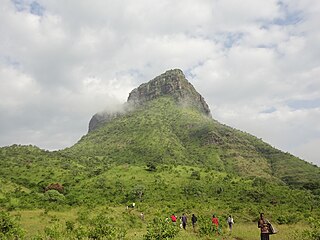Oligopithecus is a fossil primate that lived in Africa during the Early Oligocene. It is represented by one species, Oligopithecus savagei, known from one jaw bone found in Egypt.

Megistotherium is an extinct genus of hyaenodont belonging to the family Hyainailouridae that lived in Africa.

Pliohyrax, is a genus of hyracoids. It grew to sizes greatly exceeding those of any living hyrax, though it was by no means the largest member of this family.
Bathyergoides is an extinct genus of rodent from Africa thought to be related to the modern blesmols. It is the only member of the family Bathyergoididae. Fossils of Bathyergoides neotertiarius were recovered from the Early Miocene Elisabeth Bay Formation of Namibia.

Indopithecus giganteus is an extinct species of large ape that lived in the late Miocene of the Siwalik Hills in northern India. Although frequently assigned to the more well-known genus Gigantopithecus, recent authors consider it to be a distinct genus in its own right.

Samburupithecus is an extinct primate that lived in Kenya during the middle to late Miocene. The one species in this genus, Samburupithecus kiptalami, is known only from a maxilla fragment dated to 9.5 million years ago discovered in 1982 and formally described by Ishida & Pickford 1997. The type specimen KNM-SH 8531 was discovered by the Joint Japan-Kenya Expedition at the SH22 fossil site in the Samburu District, a locality where several other researchers found no ape fossils.
Rimasuchus is an extinct genus of crocodile from the Miocene of Egypt and possibly Libya. Only one species - Rimasuchus lloydi - is currently known. It was previously thought to be a species of Crocodylus, but is now thought to be more closely related to the modern African dwarf crocodiles (Osteolaemus).

Rangwapithecus is an extinct genus of ape from the Early Miocene of Kenya. Late Miocene phalanges from Hungary have also been assigned to this genus, but were later reclassified as Dryopithecus.

The geology of Namibia encompasses rocks of Paleoproterozoic, Mesoproterozoic and Neoproterozoic and Paleozoic to Cenozoic age. About 46% of the countryʼs surface are bedrock exposure, while the remainder is covered by the young overburden sediments of the Kalahari and Namib deserts.
The Elisabeth Bay Formation, alternatively spelled as Elizabeth Bay Formation, is an Early Miocene geologic formation in the Sperrgebiet, ǁKaras Region of southwestern Namibia, overlying the Blaubok Conglomerate. The freshwater green and red siltstones, sandstones, intercalations of conglomerates and claystones of the formation were deposited in a fluvial environment, infilling a paleovalley incised during the Oligocene low sea stand, which backfilled during the Burdigalian marine transgression. The Elisabeth Bay Formation provides many fossil mammals, snakes and other reptiles.

The Black Crow Limestone is an Early Eocene geologic formation in the Sperrgebiet, ǁKaras Region of southwestern Namibia. The limestones of the approximately 10 metres (33 ft) thin formation were deposited in a lacustrine to paludal environment. The formation provides many fossil mammals and amphibians, reptiles, fresh water snails and fish.

Nyanzapithecus pickfordi is an extinct species of primate from the Middle Miocene of Maboko Island, Nyanza Province, Kenya. It had an average body mass of around 10 kg (22 lb).
Microcolobus is an extinct genus of Old world monkey that lived in eastern Africa during the Late Miocene and is regarded as the first known member of the Colobinae.
The Hiwegi Formation is a geological formation on Rusinga Island in Kenya preserving fossils dating to the Early Miocene period. The Hiwegi Formation is known for the well preserved plant fossils it preserves, which indicate a tropical forest environment that underwent wet and dry periods. The middle members of the formation in particular indicate a brief period in which conditions were notably dryer with a more open environment compared to older and younger units. Some of the formation's fauna, such as an early ancestor of the modern aye-aye and a chameleon of the genus Calumma, link Miocene East Africa to modern day Madagascar.

Mount Napak is an extinct volcano in the Napak District of Uganda. Located on the northern edge of the Bokora Game Reserve, it reaches an estimated height of 2103m above sea level. An alkaline volcano which erupted carbonatite-nephelinite material during the Early Miocene on the margin of the Great Rift Valley, subsequent erosion affords volcanologists an opportunity to inspect its once internal structures. Moreover, volcanic ash deposits and paleosols preserve a range of both animal and plant fossils, significantly including numerous primate taxa.
Diamantofelis is an extinct genus of felids that lived in what is now Namibia during the Early Miocene. It contains a single species, Diamantofelis ferox.
Namafelis is an extinct genus of felids that lived in what is now Namibia during the Early Miocene. It contains a single species, Namafelis minor. Closely related to Diamantofelis, it is of “Pseudaelurus-grade”, and therefore a rather basal member of the cat family.
Namibiocyon is an extinct genus of carnivoran mammals, belonging to the family Amphicyonidae, that lived in Namibia during the Early Miocene epoch. Before the erection of this taxon in 2022, the type and only species, N. ginsburgi, had been assigned to a variety of other genera. It is notable for its adaptions toward hypercarnivory.










